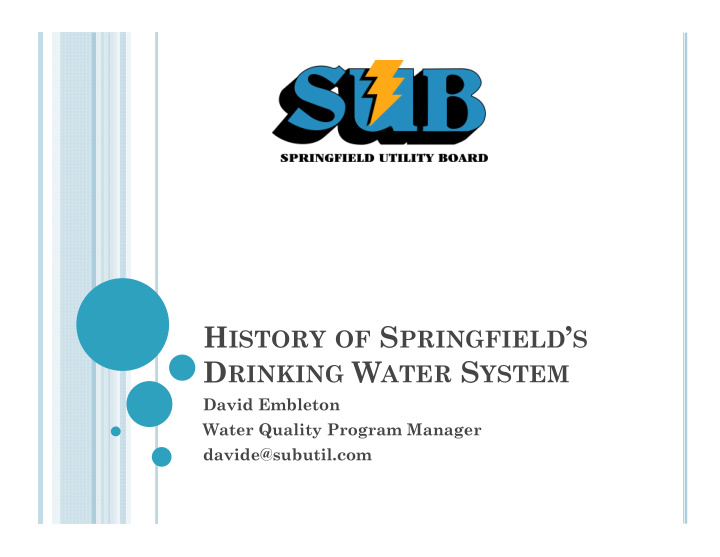



H ISTORY OF S PRINGFIELD ’ S D RINKING W ATER S YSTEM David Embleton Water Quality Program Manager davide@subutil.com
T HE M AN B EHIND SUB’ S W ATER S YSTEM H ISTORY R ESEARCH 1988 State Hwy (Main St) needs to be rebuilt State reimbursed facilities that were installed before 1929. 1906 10” wrought iron pipe (threaded 10 foot sections) …No Leaks Electric streetcar in downtown Springfield c.1910 Bart inspecting 60” main (Photo courtesy of Springfield Museum)
C ITY N AMED A FTER ITS F IRST D RINKING W ATER S UPPLY 1848 Springfield literally named after a spring in a field. Served as city’s water source until 1913. Now flows under apartments just west of downtown Population in Springfield in 1890 was 391 In 1910 Springfield populations was 1,838 Spring in a field B St & Pioneer Parkway (2 nd St) (location unknown)
F UTURE D RINKING W ATER S UPPLY FOR S PRINGFIELD 1851 Flood engulfed all of Springfield 1852-1853 Elias Briggs and others constructed the Mill Race Springfield Millrace
L ITTLE D ID I K NOW ! Middle Fork Willamette River Reconstructed Millrace intake New path along Millrace Restored Millrace channel
S PRINGFIELD ’ S F IRST M UNICIPAL D RINKING W ATER S YSTEM 1902 Booth-Kelly Lumber Company 1906 Willamette Valley Electric Company (water mains still in use) Shared 800,000 gal open reservoir Booth-Kelley Mill and City Booth-Kelley Mill Booth-Kelley Mill Site Today (Photos courtesy of Springfield Museum)
S TEAM P LANT P ROVIDED D RINKING W ATER AND P OWER Steam Plant and Millrace 1911 Steam Plant (Photo courtesy of Springfield Museum) 2014 Steam Plant / SUB pump station 1906 pump and motor
“I NK ON L INEN ” A S -B UILT 1911 Booth –Kelly built and leased a steam plant to the Oregon Power Company . Later that year, the entire Booth-Kelly site was destroyed by fire.
C LEANER W ATER S OURCE IS N EEDED 1915 Mountain States Power 1936 Water Quality Degrades (last year for log drive) New Intake upstream 3 miles Chlorine Disinfection Send water to Steam Plant through 16” wood stave pipe. Wood stave pipe (location unknown) 1920 -1.4 MG Oval Reservoir (Abandon in 1981) Mountain States Power facility (Photos courtesy of Springfield Museum)
T WO P OWER U TILITIES S ERVE S PRINGFIELD 1940 Pacific Power and Light – Water Utility Too 1950 Springfield Utility Board – Power Only 1908 Construction of power facility (Photos courtesy of Springfield Museum) 1918 water tower torn down in Seattle and rebuilt in Springfield in 1944 2014 Springfield Museum
T HREE M AJOR D RINKING W ATER P ROVIDERS S ERVE S PRINGFIELD 1950 Pacific Power and Light Digs Deep for Drinking Water McKenzie Highway Water District Taps Eugene Water and Electric Board’s (EWEB) Willamette Well McKenzie River Drinking Water Rainbow Water District (RWD) Taps EWEB’s McKenzie River Drinking Water 1950 60,000 gal yellow cedar tank, 1950 square reservoir replaced with 150,000 gallon steal tank (Abandon in 1981)
N EW G ROUND W ATER S OURCE IN S PRINGFIELD 1956 McKenzie Highway Water District and Rainbow Water District teamed up to drill wells. These wells feed East and North Springfield Rainbow Water District Shared well supplies East and North Springfield McKenzie Hwy Water District Pacific Power & Light Rehab of shared well
S PRINGFIELD U TILITY B OARD (SUB) E NTERS INTO W ATER B USINESS 1960 City annexes East Springfield Assets of McKenzie Highway Water Districts go to City and then to SUB. East Springfield Well 1966 Well driller comes to SUB with an offer. Construction East Springfield well construction East Springfield 50,000 cedar tank construction
R IVER D RIES U P FOR P ACIFIC P OWER & L IGHT 1963 Flood diverts Willamette River away from water intakes. Gravel mining ponds Middle Fork Willamette River (at intake location) Dredged channel to intake Middle Fork Willamette River (dry river bed)
SUB E XPANDS W ATER S YSTEM 1975 SUB buys Pacific Power & Light’s West Springfield water system Distribution system had 52% unaccounted for water. 1982 two new wells for East System 1995 one new well for North System 1995 elevated tower is removed Elevated tower 1944-1995 2014 Elevated tower removed
W ERE ARE WE TODAY Recently constructed two new Corrosion Control facilities. Recently constructed UV Disinfection System for a Groundwater Under the Direct Influence of Surface Water Well Evaluating new source options through an extensive source water planning effort. Evaluating the seismic integrity of our water system/reservoirs. W HAT ARE S OME C HALLENGES IN O UR F UTURE The biggest challenge for us is “not what we know but what we do not know.” Regulation changes affecting water quality, material use and other standards make it hard to predict the future budgets and rate increases. Regulation changes affecting water quality, material use and other standards make it hard to Generational changes in employee attitudes towards work responsibilities. Although SUB is progressive with our infrastructure replacement and maintenance this will continue to be a challenge.
Thank you Questions??
Recommend
More recommend